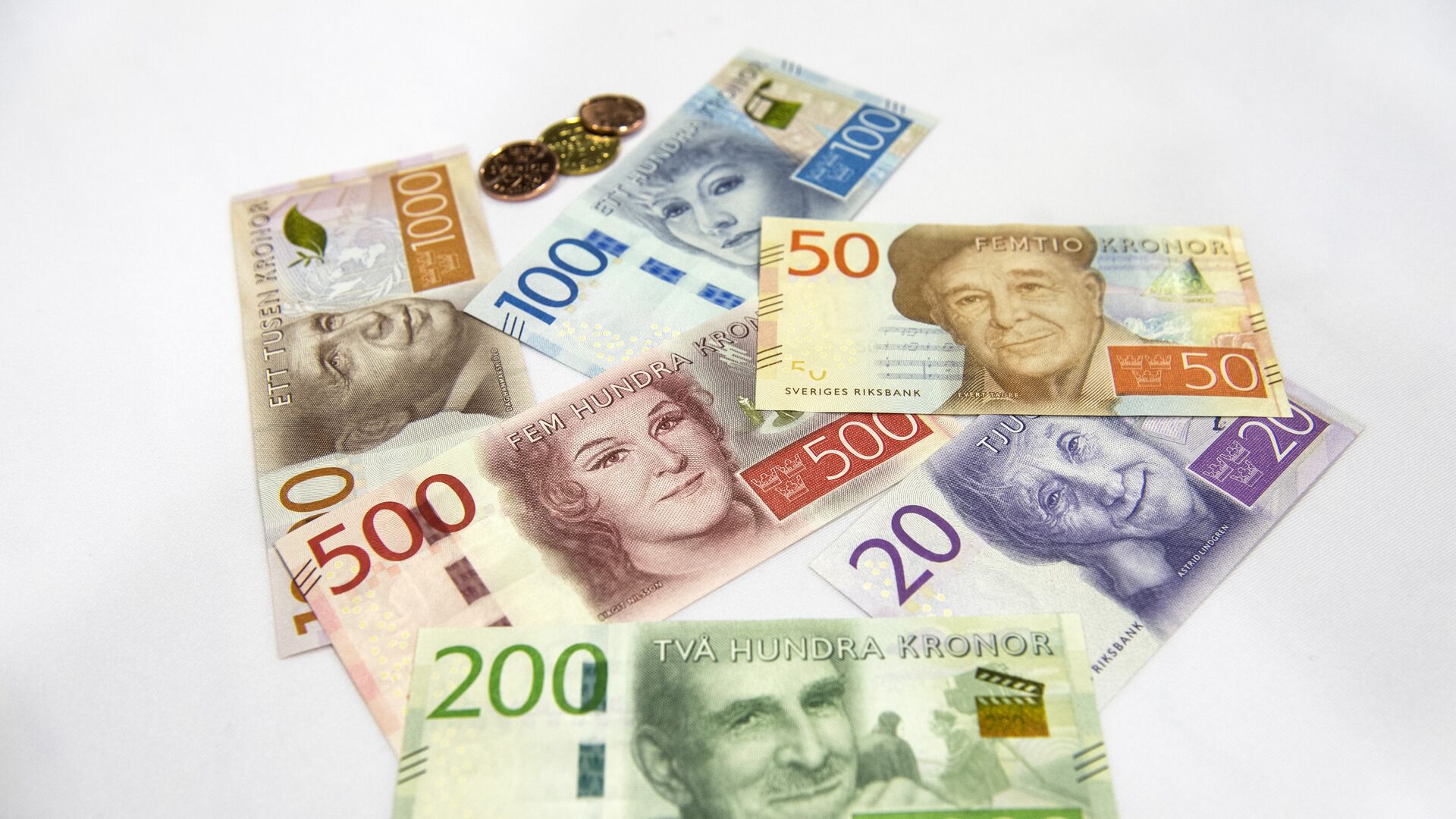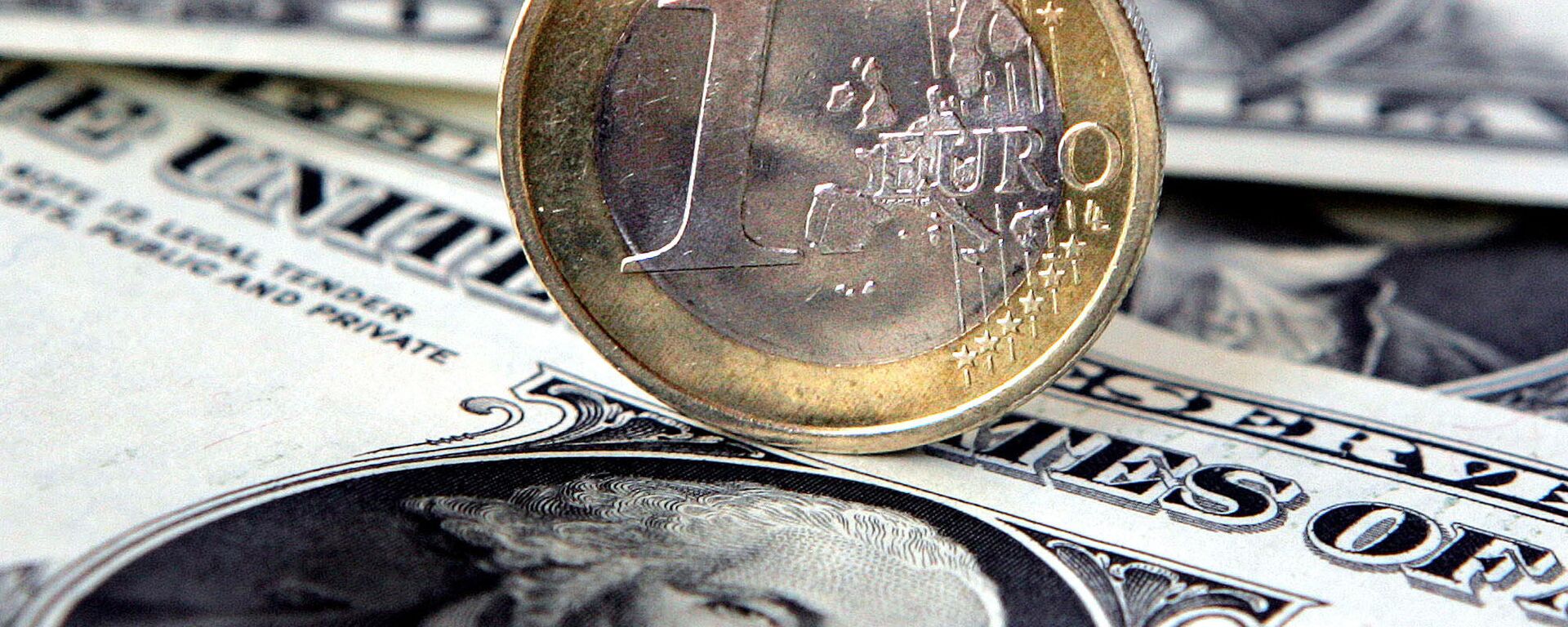https://sputnikglobe.com/20220719/swedish-krona-reaches-weakest-level-in-decades-hampering-countrys-trade-1097445068.html
Swedish Krona Reaches Weakest Level in Decades, Hampering Country's Trade
Swedish Krona Reaches Weakest Level in Decades, Hampering Country's Trade
Sputnik International
The fall of the Swedish krona, unseen in decades, has been ascribed to a combination of factors such as a shaky world economy, US interest rate hikes, the... 19.07.2022, Sputnik International
2022-07-19T07:26+0000
2022-07-19T07:26+0000
2022-07-19T07:26+0000
scandinavia
newsfeed
currency
sweden
dollar
euro
https://cdn1.img.sputnikglobe.com/img/105030/33/1050303378_0:0:5482:3084_1920x0_80_0_0_9189f5dbd873210f8ed75d54458e6c9e.jpg
A record cheap Swedish krona in combination with accelerating inflation has made it difficult for Swedish companies operating in an international market and trading heavily in US dollars.The Swedish krona has reached a 20-year low and is close to reaching its lowest level ever. Not since 2001-2002, which saw economic woes amid the Dotcom bubble burst, has the krona been so undervalued against the US dollar.The weak krona has been pinned on the protracted period of low interest rates set by the country's Central Bank.According to the newspaper Svenska Dagbladet, the krona may be en route to a new low against the dollar due to shaky world economy, US interest rate hikes, falling property prices and the Central Bank's attempts to keep the krona weak.The krona is now beginning to approach its weakest level ever against the US currency. Today, a dollar costs around SEK 10.50, compared with just over SEK 8 a year ago and just over SEK 11 when the krona was at its weakest during the tech crash of 2001.SEB head of analysis Carl Hammer told the newspaper Dagens Nyheter that the krona's exchange rate “has very little to do with what is happening in Sweden,” instead pointing out the euro's massive deprecation against the dollar and Europe's acute energy crisis, which has been exacerbated by the conflict in Ukraine and sanctions.The flip side, however, is that the anemic krona, coupled with soaring inflation rates, does an ill service to Swedish companies active in the international market.“What we have to do is of course work with the current pricing and make sure we can handle it in a decent and good way. In other respects, in the longer term you can consider finding other suppliers who are in other currency areas,” Kristensson mused. “These are natural changes in an economy and we cannot influence them. Therefore, we adapt to the current situation.”According SEB's Carl Hammer, the European Central Bank is not in a position to take drastic steps in the current the economic situation in Europe.The euro has fallen to parity with the dollar for the first time since 2002, during the early years of its existence. During the 2008 global financial crisis, one euro was worth about 1.6 US dollars.
https://sputnikglobe.com/20220714/new-normal-how-us-dollar-and-energy-crunch-are-eating-away-at-euros-strength-1097322553.html
scandinavia
sweden
Sputnik International
feedback@sputniknews.com
+74956456601
MIA „Rossiya Segodnya“
2022
News
en_EN
Sputnik International
feedback@sputniknews.com
+74956456601
MIA „Rossiya Segodnya“
Sputnik International
feedback@sputniknews.com
+74956456601
MIA „Rossiya Segodnya“
scandinavia, newsfeed, currency, sweden, dollar, euro
scandinavia, newsfeed, currency, sweden, dollar, euro
Swedish Krona Reaches Weakest Level in Decades, Hampering Country's Trade
The fall of the Swedish krona, unseen in decades, has been ascribed to a combination of factors such as a shaky world economy, US interest rate hikes, the Central Bank's low interest rates, the euro's massive deprecation against the dollar and Europe's acute energy crisis, which has been exacerbated by the conflict in Ukraine and sanctions.
A record cheap Swedish krona in combination with accelerating inflation has made it difficult for Swedish companies operating in an international market and trading heavily in US dollars.
The Swedish krona has reached a 20-year low and is close to reaching its lowest level ever. Not since 2001-2002, which saw economic woes amid the Dotcom bubble burst, has the krona been so undervalued against the US dollar.
The weak krona has been pinned on the protracted period of low interest rates set by the country's Central Bank.
“They have had a very low interest rate, for a long time even negative interest rates, and they have said that they want a weak currency to create inflation. This has reduced the appetite from the outside world to buy Swedish kronor,” SEB bank senior economist Robert Bergqvist explained to SVT.
According to the newspaper
Svenska Dagbladet, the krona may be en route to a new low against the dollar due to shaky world economy, US interest rate hikes, falling property prices and the Central Bank's attempts to keep the krona weak.
The krona is now beginning to approach its weakest level ever against the US currency. Today, a dollar costs around SEK 10.50, compared with just over SEK 8 a year ago and just over SEK 11 when the krona was at its weakest during the tech crash of 2001.
SEB head of analysis Carl Hammer
told the newspaper
Dagens Nyheter that the krona's exchange rate “has very little to do with what is happening in Sweden,” instead pointing out the euro's massive deprecation against the dollar and Europe's acute energy crisis, which has been exacerbated by the conflict in Ukraine and sanctions.
The flip side, however, is that the anemic krona, coupled with soaring inflation rates, does an ill service to Swedish companies active in the international market.
“Above all, it is that certain raw materials and certain input materials are changing. There are lots of components that are only traded in dollars and thus they get a higher price,” Sven Kristensson, CEO of industrial air purification company Nederman, told SVT. The company is active worldwide and has a lot of production in the US, which helps mitigate the impact of the weak krona.
“What we have to do is of course work with the current pricing and make sure we can handle it in a decent and good way. In other respects, in the longer term you can consider finding other suppliers who are in other currency areas,” Kristensson mused. “These are natural changes in an economy and we cannot influence them. Therefore, we adapt to the current situation.”
According SEB's Carl Hammer, the European Central Bank is not in a position to take drastic steps in the current the economic situation in Europe.
“They must keep a balance between declining growth and severe inflation. They proceed more carefully, considering how difficult it can be, for example in case of gas rationing or if factories need to be closed,” Hammer mused, stressing a big effect on Sweden. “We are exposed to Europe in terms of growth. Although there are opportunities to keep growth up in Sweden, it is clear in the foreign exchange market that the krona is strongly pegged to the euro,” he concluded.
The euro has fallen to parity with the dollar for the first time since 2002, during the early years of its existence. During the 2008 global financial crisis, one euro was worth about 1.6 US dollars.


